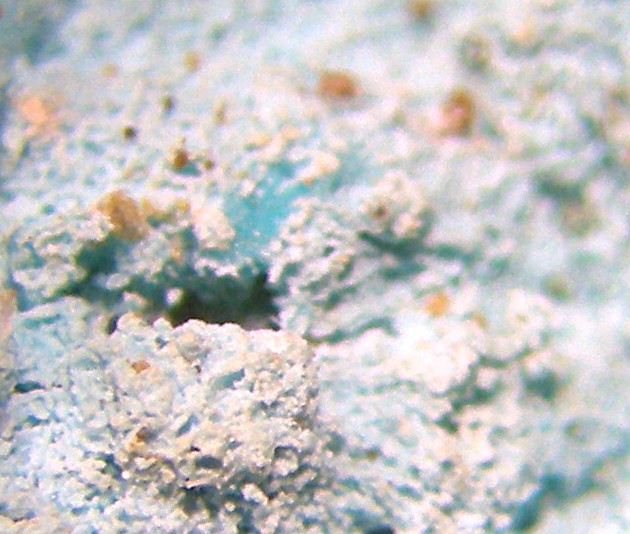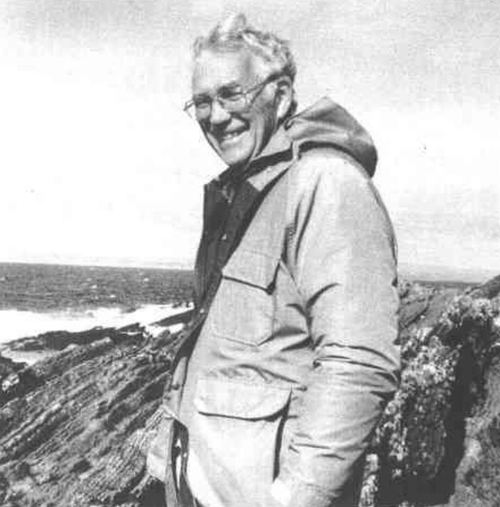Anthonyite
A valid IMA mineral species
This page is currently not sponsored. Click here to sponsor this page.
About Anthonyite
Formula:
Cu(OH,Cl)2 · 3H2O
Colour:
Lavender
Hardness:
2
Crystal System:
Monoclinic
Name:
Named by Sidney A. William in 1963 in honor of John Williams Anthony (25 November 1920, Brockton, Massachusetts, USA - 8 November 1992), Professor of Mineralogy in the University of Tucson, Arizona, USA. He was a coauthor of the Handbook of Mineralogy project, author of the Mineralogy of Arizona.
Unique Identifiers
Mindat ID:
253
Long-form identifier:
mindat:1:1:253:6
GUID
(UUID V4):
(UUID V4):
3150251e-1638-4bd1-aea1-465b8450ac3c
IMA Classification of Anthonyite
Approved
IMA Formula:
Cu(OH)2 · 3H2O
Approval year:
1967
First published:
1963
Classification of Anthonyite
3.DA.40
3 : HALIDES
D : Oxyhalides, hydroxyhalides and related double halides
A : With Cu, etc., without Pb
3 : HALIDES
D : Oxyhalides, hydroxyhalides and related double halides
A : With Cu, etc., without Pb
6.2.6.1
6 : HYDROXIDES AND OXIDES CONTAINING HYDROXYL
2 : X(OH)2
6 : HYDROXIDES AND OXIDES CONTAINING HYDROXYL
2 : X(OH)2
8.2.9
8 : Halides - Fluorides, Chlorides, Bromides and Iodides; also Fluoborates and Fluosilicates
2 : Halides of Cu
8 : Halides - Fluorides, Chlorides, Bromides and Iodides; also Fluoborates and Fluosilicates
2 : Halides of Cu
Mineral Symbols
As of 2021 there are now IMA–CNMNC approved mineral symbols (abbreviations) for each mineral species, useful for tables and diagrams.
| Symbol | Source | Reference |
|---|---|---|
| Aty | IMA–CNMNC | Warr, L.N. (2021). IMA–CNMNC approved mineral symbols. Mineralogical Magazine, 85(3), 291-320. doi:10.1180/mgm.2021.43 |
Pronunciation of Anthonyite
Pronunciation:
| Play | Recorded by | Country |
|---|---|---|
| Jolyon Ralph | United Kingdom |
Physical Properties of Anthonyite
Transparency:
Translucent
Colour:
Lavender
Hardness:
2 on Mohs scale
Tenacity:
Sectile
Cleavage:
Distinct/Good
on {100}
on {100}
Optical Data of Anthonyite
Type:
Biaxial (-)
RI values:
nα = 1.526 nβ = 1.602 nγ = 1.602
2V:
Measured: 3°
Max Birefringence:
δ = 0.076

Image shows birefringence interference colour range (at 30µm thickness)
and does not take into account mineral colouration.
and does not take into account mineral colouration.
Surface Relief:
Moderate
Dispersion:
relatively weak
Pleochroism:
Weak
Comments:
X = rich lavender, Y = Z = deep smoky blue, Orientation: Y = b, Z vs. b = 13°
Chemistry of Anthonyite
Mindat Formula:
Cu(OH,Cl)2 · 3H2O
Elements listed:
Crystallography of Anthonyite
Crystal System:
Monoclinic
Class (H-M):
2/m - Prismatic
Morphology:
Prismatic crystals, commonly curved along [001]
Comment:
Space group not determined; only beta angle given.
X-Ray Powder Diffraction
Powder Diffraction Data:
| d-spacing | Intensity |
|---|---|
| 5.84 Å | (10) |
| 4.14 Å | (7) |
| 3.99 Å | (6) |
| 3.44 Å | (6) |
| 2.87 Å | (6) |
| 3.18 Å | (4) |
| 3.07 Å | (4) |
Comments:
Recorded on material from the type locality
Geological Environment
Paragenetic Mode(s):
| Paragenetic Mode | Earliest Age (Ga) |
|---|---|
| Stage 3a: Earth’s earliest Hadean crust | >4.50 |
| 10 : Basalt-hosted zeolite minerals |
Type Occurrence of Anthonyite
General Appearance of Type Material:
as prismatic crystals, commonly curved, to 1 cm; as crusts
Place of Conservation of Type Material:
National Museum of Natural History, Washington, D.C., USA (Nos. 142653 and 162617)
Geological Setting of Type Material:
In cavities and fractures in basalt, formed by the action of chlorine-bearing connate waters on copper
Associated Minerals at Type Locality:
Reference:
Williams, S.A. (1963) Anthonyite and calumetite, two new minerals from the Michigan copper district. American Mineralogist: 48: 614-619.
Other Language Names for Anthonyite
German:Anthonyit
Spanish:Anthonyita
Common Associates
Associated Minerals Based on Photo Data:
Related Minerals - Strunz-mindat Grouping
| 3.DA. | Centennialite | CaCu3Cl2(OH)6 · nH2O (n ~ 0.7) |
| 3.DA. | Muonionalustaite | Ni3(OH)4Cl2 · 4H2O |
| 3.DA. | Parahibbingite | Fe2(OH)3Cl |
| 3.DA. | Bounahasite | Cu+Cu2+2(OH)3Cl2 |
| 3.DA.05 | Melanothallite | Cu2Cl2O |
| 3.DA.10a | Atacamite | Cu2(OH)3Cl |
| 3.DA.10b | Botallackite | Cu2(OH)3Cl |
| 3.DA.10b | Clinoatacamite | Cu2(OH)3Cl |
| 3.DA.10a | Hibbingite | Fe2+2(OH)3Cl |
| 3.DA.10a | Kempite | Mn2+2(OH)3Cl |
| 3.DA.10c | Kuliginite | Fe3Mg(OH)6Cl2 |
| 3.DA.10c | Paratacamite | Cu3(Cu,Zn)(OH)6Cl2 |
| 3.DA.10b | Belloite | Cu(OH)Cl |
| 3.DA.10c | Herbertsmithite | Cu3Zn(OH)6Cl2 |
| 3.DA.10c | Kapellasite | Cu3Zn(OH)6Cl2 |
| 3.DA.10c | Gillardite | Cu3Ni(OH)6Cl2 |
| 3.DA.10c | Haydeeite | Cu3Mg(OH)6Cl2 |
| 3.DA.10c | Leverettite | Cu3Co(OH)6Cl2 |
| 3.DA.10c | Paratacamite-(Ni) | Cu3(Ni,Cu)(OH)6Cl2 |
| 3.DA.10c | Tondiite | Cu3Mg(OH)6Cl2 |
| 3.DA.10c | Misakiite | Cu3Mn(OH)6Cl2 |
| 3.DA.10b | Iyoite | MnCuCl(OH)3 |
| 3.DA.10b | Unnamed (Cu-Zn Chloride Hydroxide) | CuZnCl(OH)3 |
| 3.DA.15 | Claringbullite | Cu4ClF(OH)6 |
| 3.DA.15 | Barlowite | Cu4BrF(OH)6 |
| 3.DA.20 | Simonkolleite | Zn5Cl2(OH)8 · H2O |
| 3.DA.25 | Buttgenbachite | Cu19(NO3)2(OH)32Cl4 · 2H2O |
| 3.DA.25 | Connellite | Cu19(SO4)(OH)32Cl4 · 3H2O |
| 3.DA.30 | Abhurite | Sn21Cl16(OH)14O6 |
| 3.DA.35 | Ponomarevite | K4Cu4Cl10O |
| 3.DA.40 | Calumetite | CaCu4(OH)8Cl2 · 3.5H2O |
| 3.DA.45 | Khaidarkanite | Cu4Al3(OH)14F3 · 2H2O |
| 3.DA.50 | Bobkingite | Cu5Cl2(OH)8 · 2H2O |
| 3.DA.55 | Avdoninite | K2Cu5(OH)4Cl8 · H2O |
| 3.DA.60 | Droninoite | Ni6Fe3+2(OH)16Cl2 · 4H2O |
| 3.DA.70 | Chrysothallite | K6Cu6Tl3+Cl17(OH)4 · H2O |
| 3.DA.70 | Dioskouriite | CaCu4Cl6(OH)4 · 4H2O |
| 3.DA.75 | Feodosiyite | Cu11Mg2Cl18(OH)8 · 16H2O |
| 3.DA.80 | Romanorlovite | K8Cu6Cl17(OH)3 |
Other Information
Special Storage/
Display Requirements:
Display Requirements:
Dehydration in air begins a few weeks after the material has been indoors and then proceeds rapidly.
Health Risks:
No information on health risks for this material has been entered into the database. You should always treat mineral specimens with care.
Internet Links for Anthonyite
mindat.org URL:
https://www.mindat.org/min-253.html
Please feel free to link to this page.
Please feel free to link to this page.
Search Engines:
External Links:
Mineral Dealers:
References for Anthonyite
Localities for Anthonyite
Locality List
 - This locality has map coordinates listed.
- This locality has map coordinates listed.
 - This locality has estimated coordinates.
ⓘ - Click for references and further information on this occurrence.
? - Indicates mineral may be doubtful at this locality.
- This locality has estimated coordinates.
ⓘ - Click for references and further information on this occurrence.
? - Indicates mineral may be doubtful at this locality.
 - Good crystals or important locality for species.
- Good crystals or important locality for species.
 - World class for species or very significant.
(TL) - Type Locality for a valid mineral species.
(FRL) - First Recorded Locality for everything else (eg varieties).
- World class for species or very significant.
(TL) - Type Locality for a valid mineral species.
(FRL) - First Recorded Locality for everything else (eg varieties).
All localities listed without proper references should be considered as questionable.
Germany | |
| Weiß (1990) |
Greece | |
| 42. +1 other reference |
Mexico | |
| J. W. Anthony et al.: Handbook of Mineralogy (1997) |
USA | |
| Graeme (1981) +1 other reference |
| Raman analyzed at the University of ... |
| Williams (1963) +1 other reference |
Quick NavTopAbout AnthonyiteUnique IdentifiersIMA Classification Classification Mineral SymbolsPronunciation Physical Properties Optical Data Chemistry Crystallography X-Ray Powder DiffractionGeological EnvironmentType Occurrence Other LanguagesCommon AssociatesStrunz-MindatOther InformationInternet Links References Localities Locality List





 symbol to view information about a locality.
The
symbol to view information about a locality.
The 



Villa Hermosa, Puerto Penasco Municipality, Sonora, Mexico